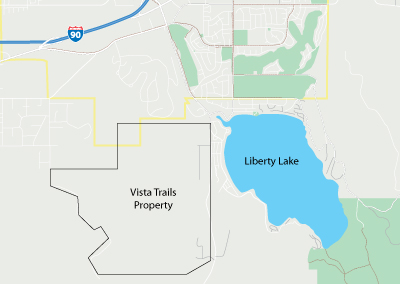- Proposed park could preserve LL-area hillside
Source: Liberty Lake Splash; August 18, 2010
Summary: The failure of the Marshall Chesrown's Legacy Ridge development has left the property in the hands of AmericanWest Bank. The bank has proposed that it be sold to the county through the Conservation Futures program for $2.6 million. It could include a trail system over the hillside between Liberty Lake and Saltese Flats.
Opinion: Full disclosure: as a city councilmember for Liberty Lake, I lobbied to deny this area’s entry into the urban growth area (which would have allowed it to be developed), and that effort was successful. So, I’m naturally drawn to making it a protected area and preventing it from being developed. County Commissioner Mark Richard even came to Liberty Lake to threaten the city with legal action if we didn’t support bringing it in. So, to have Commissioner Richard making the decision? I seriously doubt it will be protected. On the other hand, this next story indicates it’s unlikely to happen anyway.... - Open space designation fields many nominees in county
Source: Spokesman-Review; September 2, 2010
Summary: Thirty-six parcels have been nominated to be acquired by Spokane County under the Conservation Futures program. Conservation Futures is funded through a special property tax dedicated to the purchase and preservation of threatened open spaces. The Spokesman-Review web site is making a map and specific parcel list available.
Opinion: According to purpose of the Conservation Futures program is to "maintain, preserve, conserve and otherwise continue in existence adequate open space lands for the production of food, fiber and forest crops, and to assure the use and enjoyment of natural resources and scenic beauty." The county maintains a statement and park locator. The fact that there are some worthwhile properties available which exceed the available annual funding is more proof that the purchase of the YMCA building in Riverfront Park was unwise. And this unfortunate funding restriction will persist for 20 years unless the park property is repurchased using unrestricted funds and Conservation Futures is refunded. - Solar panels provide backup power for Liberty Lake police
Source: Spokesman-Review; September 2, 2010
Summary: The City of Liberty Lake has installed 60 solar panels on the roof of the police station/library building. The police department has a bank of batteries which can power its servers and communications equipment. The solar panels will keep the batteries available for up to 72 hours during a power outage. During normal operation, the solar panels will reduce the amount of energy purchased from Avista. Excess power will be sold back to Avista.
Opinion: Proof that sustainability and resilience are two sides of the same coin. People who are opposed to sustainability: please explain how losing data access and communications is good for public safety. - Doing More While Using Less Power
Source: New York Times; September 1, 2010
Summary: Energy efficiency is not the same as energy conservation. With conservation, you make do with less. Efficiency means that you can do more with what you already have. Appliances have become more efficient—like refrigerators have, on average become 4% more efficient each year since the 70’s, yet are larger. Light duty vehicles could double their efficiency by 2035. Buildings could use 60% less energy by installing present technologies. One researcher says that the United States could reduce its projected energy needs by 88 percent by 2050.
Opinion: Reduce by 88 percent. No, I checked. That’s not a typo. As is observed in the article, this is easy stuff but industry seems to be "utterly uninterested." Yes, it can take upfront investment, but what doesn’t? And with up to 40 percent return on investment, there is a serious disconnect here. Perhaps Mayor Newsom’s building efficiency audits would help. It might even help more if the stockholders were informed of ways to make those kinds of margins. Or, better yet, disinvest in poorly performing companies and invest in businesses (and regions) which are more efficient and better prepared to succeed in tight markets.
Four the Future - September 3
Today: Conservation Futures, public safety with a sunny disposition, and energy efficiency projections.
Subscribe to:
Post Comments (Atom)
i have looked at planning for awhile, but i am having a questioning moment about what is the difference or is there a difference between conservation futures, and the transfer of development rights. Snohomish County has some very pristine areas that are not protected from development, a desire to create urban centers, and a desire to protect farmland from development. Any comments or direction that would help with my understanding of this issue.
ReplyDeleteConservations futures is the tax-funded acquisition of land by a county, as authorized by chapter 84.34 RCW. Section 230 says that "a county may levy an amount not to exceed six and one-quarter cents per thousand dollars of assessed valuation" for acquiring and maintaining such lands. So, in effect, a county can tax people to buy land or development rights. Separately, the chapter also authorizes certain lands to be declared open space, and receive a reduction in assessed valuation for the time during which it is declared open space. These stories are about the actual purchase of lands.
ReplyDeleteTransfer of Development Rights is a method by which a property owner can voluntarily give up his right to develop a property in exchange for the ability to increase their right to develop somewhere else. For instance, if someone has 200 acres for which the zoning permits 1 unit for every 20 acres, he had the right to build 10 units on that lot. With a transfer of development rights, they could build those ten domestic units on a different piece of property, if they extinguish their rights on the original parcel. The purpose is to preserve open space, while densifying urban places. In effect, they "transfer" the houses from a rural environment to an urban environment.
Gosh, we may need a Planopedia.